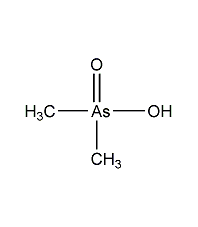
Structural formula
| Business number | 01JV |
|---|---|
| Molecular formula | C2H7AsO2 |
| Molecular weight | 138.00 |
| label |
Dimethylarsinic acid, herbicide |
Numbering system
CAS number:75-60-5
MDL number:MFCD00002095
EINECS number:200-883-4
RTECS number:CH7525000
BRN number:1736965
PubChem number:24892235
Physical property data
1. Characteristics: colorless crystals.
2. Density (g/mL,25/4℃): Unsure
3. Relative vapor density (g/mL,AIR=1): Unsure
4. Melting point (ºC):192 -198℃
5. Boiling point (ºC,Normal pressure): Uncertain
6. Boiling point (ºC,5.2kPa): Unsure
7. Refractive index: Uncertain
8. Flash Point (ºC): Unsure
9. Specific optical rotation (º): Unsure
10. Autoignition point or ignition temperature (ºC): Unsure
11. Vapor pressure (kPa,25ºC): Unsure
12.
7. Number of heavy atoms: 5
8. Surface charge: 0
9. Complexity: 62
10. Number of isotope atoms: 0
11. Determine the number of atomic stereocenters: 0
12. The number of uncertain atomic stereocenters: 0
13. Determine the number of stereocenters of chemical bonds: 0
14. Uncertain number of chemical bond stereocenters: 0
15. Number of covalent bond units: 1
Properties and stability
Reacts with moisture, air, and oxides.
Storage method
Store airtightly,Store in a cool, dark place Dry warehouse. Avoid contact with moisture, water, and air.
Synthesis method
Reduced by disodium methylarsinate with sulfur dioxide, and then under alkaline conditions It reacts with methyl chloride to form sodium dimethylarsinate,, which is then treated with hydrochloric acid.
Purpose
Used to control weeds in non-crop fields,Dosage10~15kg/ha
style=”mso-list: Ignore”>15. Covalent Number of key units: 1
Properties and stability
Reacts with moisture, air, and oxides.
Storage method
Store airtightly,Store in a cool, dark place Dry warehouse. Avoid contact with moisture, water, and air.
Synthesis method
Reduced by disodium methylarsinate with sulfur dioxide, and then under alkaline conditions It reacts with methyl chloride to form sodium dimethylarsinate,, which is then treated with hydrochloric acid.
Purpose
Used to control weeds in non-crop fields,Dosage10~15kg/ha

 微信扫一扫打赏
微信扫一扫打赏

